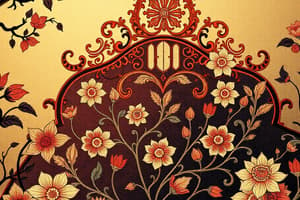Podcast
Questions and Answers
What is the purpose of CSS?
What is the purpose of CSS?
To specify the appearance of HTML elements.
How can you link a CSS file to an HTML document?
How can you link a CSS file to an HTML document?
Using the tag in the section of the HTML file.
What is the purpose of type selectors in CSS?
What is the purpose of type selectors in CSS?
To target elements based on their HTML tag.
How do you target elements with a specific class attribute in CSS?
How do you target elements with a specific class attribute in CSS?
What is the syntax for targeting elements with a specific ID attribute in CSS?
What is the syntax for targeting elements with a specific ID attribute in CSS?
What are CSS selectors used for?
What are CSS selectors used for?
What is the purpose of attribute selectors in CSS?
What is the purpose of attribute selectors in CSS?
Give an example of using attribute selectors in CSS.
Give an example of using attribute selectors in CSS.
What does the 'Color' property in CSS do?
What does the 'Color' property in CSS do?
Provide an example of using the 'Color' property in CSS.
Provide an example of using the 'Color' property in CSS.
What does the 'Font' property in CSS specify?
What does the 'Font' property in CSS specify?
Give an example of using the 'Font' property in CSS.
Give an example of using the 'Font' property in CSS.
What does the 'Background' property in CSS do?
What does the 'Background' property in CSS do?
Provide an example of using the 'Background' property in CSS.
Provide an example of using the 'Background' property in CSS.
What does the 'Layout' property in CSS define?
What does the 'Layout' property in CSS define?
Give an example of using the 'Layout' property in CSS.
Give an example of using the 'Layout' property in CSS.
What do CSS transitions and animations allow you to create?
What do CSS transitions and animations allow you to create?
How can the 'transition' property be used in CSS?
How can the 'transition' property be used in CSS?
What are some modern CSS features mentioned in the text?
What are some modern CSS features mentioned in the text?
Flashcards are hidden until you start studying
Study Notes
CSS: Cascading Style Sheets
Cascading Style Sheets (CSS) is a styling language used to specify the appearance of HTML elements. It allows web developers to create visually appealing and user-friendly websites by defining the layout, colors, fonts, and other visual properties of HTML elements. In this article, we will explore the basics of CSS, its syntax, and some practical examples to help you get started with styling your web content.
CSS Basics
To start using CSS, you need to link a CSS file to your HTML document using the <link> tag in the <head> section of your HTML file. For example:
<link href="styles/style.css" rel="stylesheet">
This line of code links to an external CSS file named style.css, which will apply the styles to the HTML elements in your document.
CSS Selectors
CSS selectors are used to target specific elements in your HTML document and apply styles to them. There are several types of selectors, including:
- Type selectors: Target elements based on their HTML tag, such as
h1orp. For example:
h1 {
color: red;
}
- Class selectors: Target elements with a specific class attribute, such as
.important. For example:
.important {
font-weight: bold;
}
- ID selectors: Target elements with a specific ID attribute, such as
#example. For example:
#example {
color: blue;
}
- Attribute selectors: Target elements based on their attributes, such as
[href]. For example:
a[href*="example.com"] {
color: green;
}
CSS Properties and Values
CSS properties and values are used to define the appearance and layout of HTML elements. Some common properties include:
- Color: Sets the color of an element's text and background. For example:
p {
color: red;
}
- Font: Specifies the font family, size, and weight of an element's text. For example:
body {
font-family: Arial, sans-serif;
font-size: 14px;
font-weight: normal;
}
- Background: Applies a background image, color, or gradient to an element. For example:
body {
background-image: url("background.jpg");
background-color: #f0f0f0;
}
- Layout: Defines the position, size, and layout of elements on the page. For example:
container {
display: flex;
justify-content: space-between;
}
CSS Transitions and Animations
CSS transitions and animations allow you to create smooth visual effects when changing the appearance of elements on your page. For example, you can use the transition property to create a smooth animation when changing the color or size of an element:
p {
transition: color 0.5s, transition-timing-function: ease;
}
In this example, the color of the paragraph element transitions from red to blue over 0.5 seconds using an ease transition.
Experimenting with Modern CSS Features
To learn more about modern CSS features, you can explore articles and tutorials on websites like Smashing Magazine. Some modern CSS features include CSS masks, CSS variables (also known as CSS constants), and trigonometric functions. Experimenting with these features can help you create more complex and visually stunning web designs.
Conclusion
CSS is a powerful tool for styling web content and creating visually appealing websites. By understanding the basics of CSS, selectors, properties, and values, you can start building efficient and stylish web designs. Don't forget to explore modern CSS features and techniques to stay up-to-date with the latest web development trends.
Studying That Suits You
Use AI to generate personalized quizzes and flashcards to suit your learning preferences.




